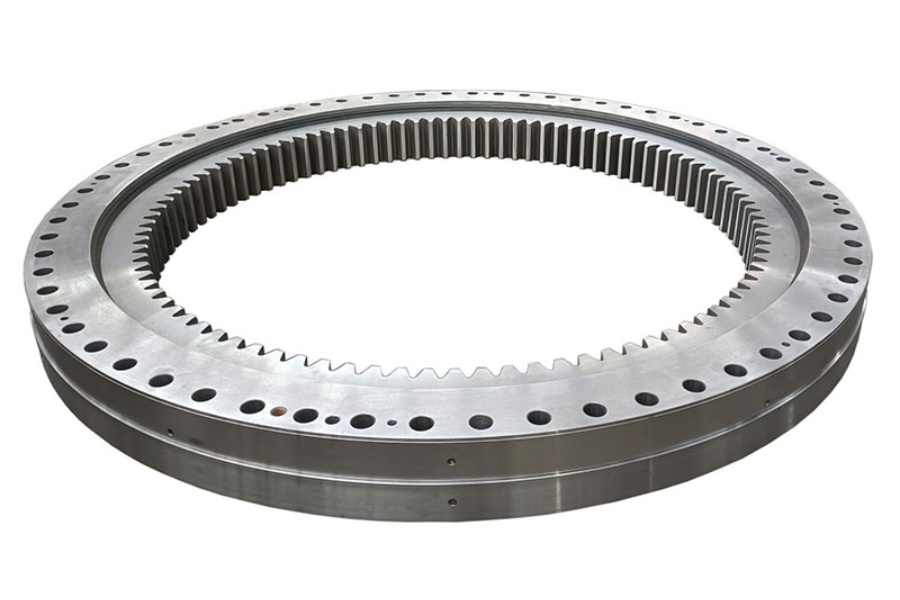
What is a Double Row Ball Slewing Ring Bearing?
What is a Double Row Ball Slewing Ring Bearing?
A Double Row Ball Slewing Ring Bearing is a heavy-duty rotary bearing with two rows of balls arranged between its inner and outer rings. Unlike single-row bearings, this design spreads loads across both rows, allowing it to handle higher axial, radial, and moment (tilting) forces simultaneously. Think of it as the "workhorse" of slewing bearings – it’s built for tough jobs where single-row bearings might buckle under pressure. The two rows of balls are typically angled (like 45° or 30°) to optimize load distribution, making these bearings ideal for applications requiring high stiffness, smooth rotation, and long-term reliability under heavy stress.
Types of Double Row Ball Slewing Ring Bearings
Standard Double Row Ball:
Basic design with two rows of balls, no gears. Used for general heavy-duty rotation.
Gear-Integrated:
Inner or outer ring has gear teeth for direct motor/gearbox coupling (common in cranes or wind turbines).
Flange-Mounted:
Includes flanges for easy bolting to machinery – saves installation time.
Sealed vs. Open:
Sealed types use rubber or metal shields to block dirt/water.
Open types allow custom lubrication but need frequent maintenance.
Precision-Grade:
Ultra-smooth raceways and tighter tolerances for applications like medical scanners or optical systems.
Split Design:
Ring is split into halves for easier installation in hard-to-reach spaces (e.g., large mining equipment).
Key Features of Double Row Ball Slewing Ring Bearings
High Load Capacity:
Handles 2–3x the load of single-row bearings due to dual ball rows.
Stiffness:
Resists deformation under heavy loads, critical for precision tasks.
Smooth Operation:
Lower friction than roller bearings, suitable for moderate-speed rotation.
Compact for Its Strength:
Delivers heavy-load performance without the bulk of multi-row roller designs.
Durability:
Hardened steel raceways and balls resist wear, even in harsh conditions.
Versatility:
Works in horizontal or vertical orientations (e.g., tower cranes vs. excavators).
Applications of Double Row Ball Slewing Ring Bearing
Wind Turbines: Rotates nacelles to face wind direction.
Construction Equipment: Excavators, tower cranes, and concrete pumps.
Medical Imaging: MRI machines requiring smooth, precise rotation.
Material Handling: Rotary docks and heavy conveyor systems.
Defense: Turret systems in armored vehicles.
Industrial Mixers: Large agitators in chemical or food processing.
Price Range
Prices vary based on:
Size: Small bearings (300mm diameter) start at ~
1,000.Massivebearings(3,000mm+)canexceed50,000.
Material: Stainless steel costs 30–50% more than carbon steel.
Precision: Medical/aerospace-grade bearings cost 3–5x more than industrial-grade.
Gears: Adding gear teeth increases price by 20–40%.
Customization: Special coatings (e.g., anti-corrosion) or split designs add 15–30%.
Brand: European brands (SKF, Thyssenkrupp) are pricier; Asian suppliers offer budget options.
Example: A 1,200mm diameter double row ball bearing for a wind turbine costs
8,000–15,000.
Lifespan of Double Row Ball Slewing Ring Bearing
Lifespan depends on:
Load Management: Operating above 80% of rated load cuts lifespan by half.
Lubrication: Poor greasing causes 60% of failures – stick to the supplier’s schedule.
Environment: Saltwater or abrasive dust accelerates wear.
Installation: Misaligned mounts create uneven stress on balls.
Average Lifespan:
Wind turbines: 15–20 years (with regular maintenance).
Excavators: 8–12 years (high shock loads).
Medical devices: 15–25 years (light, intermittent use).
How to Choose the Right Double Row Ball Slewing Ring Bearing
Don’t wing it – follow this roadmap:
Crunch the Load Numbers
Axial Load: Vertical force (e.g., the weight of a crane boom).
Radial Load: Horizontal force (e.g., a rotating platform’s side pull).
Moment Load: Tilting force (e.g., off-center cargo on a forklift turntable).
Pro Tip: Use a safety factor of 1.5–2x your max calculated load.
Speed vs. Load Balance
Higher Speed: Opt for smaller balls and low-friction seals.
Heavier Loads: Larger balls and higher-grade steel (e.g., SAE 52100).
Environment Matters
Seals: IP67+ for wet/dirty environments (e.g., mining or offshore).
Temperature: Standard bearings handle -30°C to +120°C. Extreme cold/heat needs specialty grease.
Corrosion: Stainless steel or coatings (e.g., zinc plating) for harsh climates.
Gear or No Gear?
Gear-Integrated: Saves space if driving rotation directly (common in wind turbines).
Gearless: Cheaper if using external drives (e.g., hydraulic motors).
Mounting Setup
Bolt Holes: Ensure the hole pattern matches your machine’s baseplate.
Flanges: Simplify installation but add weight – avoid if space/weight is critical.
Split Design: Essential for large systems where dismantling the machine isn’t feasible.
Precision Requirements
Backlash: Near-zero backlash for precision tasks (e.g., radar systems).
Runout: ≤0.03mm for smooth operation in medical or optical gear.
Maintenance Plan
Sealed Units: Low maintenance but can’t be relubricated – great for inaccessible spots.
Grease Ports: Allow re-greasing but require routine checks (every 6–12 months).
Budget vs. Reliability
Budget Options: Riskier but okay for non-critical, short-term projects.
Mid-Range: Best for most industrial uses (balance cost and durability).
Premium Picks: Non-negotiable for safety-critical roles (e.g., aviation, nuclear plants).
Vet Suppliers
Certifications: ISO 9001, CE marks, material test reports.
Track Record: Ask for case studies in your industry (e.g., wind energy or construction).
Warranty: Look for at least 1–2 years on industrial bearings.
Test Before Mass Order
Run a sample under real-world loads to check heat, noise, and smoothness.
For critical apps, request Finite Element Analysis (FEA) reports from the supplier.
Common Mistakes to Avoid
Ignoring Dynamic Loads: Static load ratings don’t account for movement – always check dynamic capacity.
Wrong Seal Material: Using rubber seals in high-heat environments (they degrade quickly).
Over-Tightening Bolts: Warps the raceway, causing uneven ball wear and early failure.
Mixing Metals: Pairing stainless steel bearings with aluminum frames without insulation causes galvanic corrosion.
Skipping Alignment Checks: Even 1mm misalignment can reduce bearing life by 30%.
Double Row Double Row Ball Slewing Ring Bearing Supplier
LYRA Drive is a professional slewing bearings ,slew drive, slewdrives and gears manufacturer provides customizedslew bearing, drive and gears.For application-specific engineering solutions, contact LYRA to discuss technical specifications and implementation strategies.